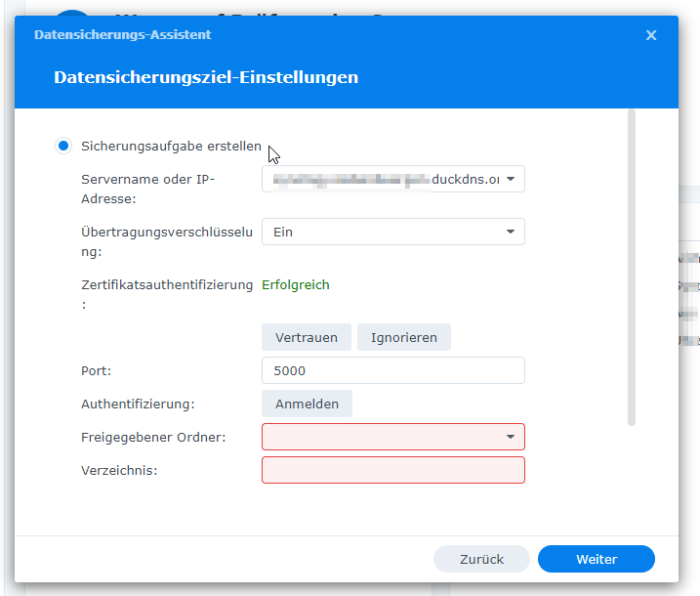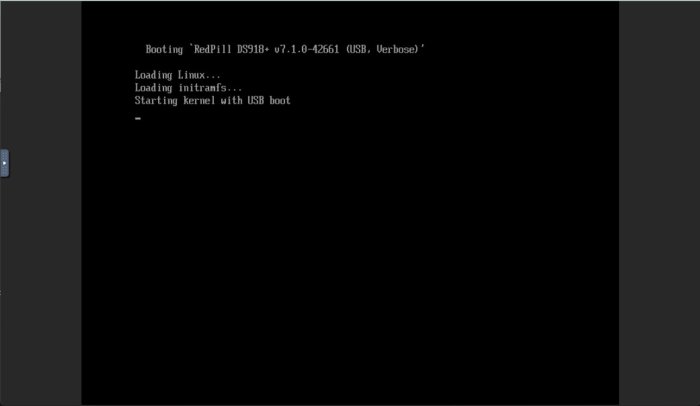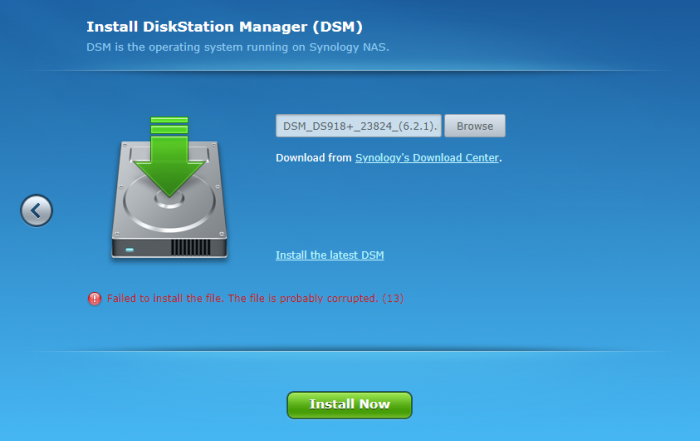Search the Community
Showing results for tags 'unraid'.
-

DSM 7.1 on UnRaid VM Hyperback to another Synology NAS
alphaboy22 posted a question in General Questions
Hi there, i just explored unraid these days and i wondered if i could run DSM on it. I used THIS tutorial and yes, it worked! Now my brother got a Synology DSM (normal one; not with unraid) and we want to store his hyper-backup into my DSM7.1 UnRaid Hyper-Vault. Anyone got experience with this? On Unraid side i'm using Nginx, so there's a DynDNS behind via DuckDNS. Also i opened port 5000 on my router. We cannot get any connection together. Anyone got some tipps or XP in this ? Thank you -
This tutorial is a supplement to the ESXi TCRP installation tutorial located here: https://xpenology.com/forum/topic/62547-tutorial-install-dsm-7x-with-tinycore-redpill-tcrp-loader-on-esxi/ Installing DSM 7.1.0.-42661 on UNRAID 6.10.3 I have been trying to install DSM 7.1 on my unraid server for the last night. After some problems and testing I have created this guide to install DSM 7.1 on UNRAID working perfectly. This is my vm config: STEP 1-Virtual machine creation: Download tiny core from https://github.com/pocopico/tinycore-redpill Select CentOS VM Template and apply correct options from the attached image. Select Q35-6.2 Select 3.0 (qemu XHCI) Load tiny red core as vdisk1 USB by selecting manually (you can create previously the name of the folder for the VM inside /domains and upload the tinycore img ) Create secondary disk 50G or whatever you want (this is your data storage for synology) as vdisk2 SATA Select Network model: e1000 Save. Uncheck "Start VM after creation" Edit again vdisk2 in the advanced xml template (top right corner) to controller='1' (if we don't do this tiny red core will not detect the disk properly when doing the satamap and will not install DSM correctly and will ask you to reinstall the *.pat infinitely) STEP 2-Start VM and connect via SSH Start VM and load tiny red core Once the OS is loaded, open the terminal and enter ifconfig to find out the ip of the machine Connect via ssh (with Putty) to the obtained IP address. user: tc password: P@ssw0rd STEP 3-Run the following commands: To update tiny red core with the latest data ./rploader.sh update now ./rploader.sh fullupgrade now To generate random mac and serial numbers (copy mac address generated to set on unraid vm template later) ./rploader.sh serialgen DS918+ (or whatever version you want, you can see all versions available with command info ./rploader.sh) To map the connected disks ./rploader.sh satamap now To record the vid/pid from usb ./rploader.sh identifyusb now To install NIC drivers (sometimes it loads the e1000e module instead of the e1000 and it doesn't work, adding this command will make sure that the e1000 module for the NIC is loaded correctly) For e1000 Network Card run: ./rploader.sh ext apollolake-7.1.0-42661 add https://raw.githubusercontent.com/pocopico/rp-ext/master/e1000/rpext-index.json NOTE: change version according your selection for CPU and DSM version For virtio-net Network Card run: ./rploader.sh ext apollolake-7.1.0-42661 add https://raw.githubusercontent.com/pocopico/rp-ext/master/v9fs/rpext-index.json NOTE: change version according your selection for CPU and DSM version To build the image ./rploader.sh build apollolake-7.1.0-42661 STEP 4-Download your .pat for your correct cpu architecture from official repo or mega download for this version apollolake , we will need it to install DSM later. https://global.download.synology.com/download/DSM/release/7.1/42661-1/DSM_DS918%2B_42661.pat - Offical repo STEP 5-Edit VM settings on advanced xml mode and install *.pat After doing all the above we shut down the machine. Edit the virtual machine on xml advanced mode (if we change mac address in normal editing mode you will lose controller="1" option set for vdisk2 we did previously so you will have to set it again everytime you change and/or save a setting from normal mode, try to edit always in xml advanced mode), look for MAC address and set the MAC generated by tiny red core. Save Start VM Select the first option USB and leave it a few minutes until we find it with synology assistant Open WebGui and install *.pat We now have DSM 7.1 working on unraid. There is other method with SATA boot but I have to test it better. Hope this guide help someone. Regards.
-
Hi All I finally got the VM working (Unraid forum) my question is to the installation on a virtual VM and the VID & PID Information: I am using the loader: synoboot-ds918_1.04b And the DSM: DSM_DS918+_23824_(6.2.1).pat I have updated the Mac & license generated So after "find.synology.com" and the installation I keep getting the: Since this is a virtual USB I dont have a VID & PID Anyone else who have had this problem? To other Unraid users the post for setting this up is located here: https://forums.unraid.net/topic/71316-xpenology-vm-any-one-running-this/ Best regards & a happy New year! Casperse
-
Hallo, ich versuche jetzt schon eine ganze Weile mir Infos zur Installation von Xpenology auf einem Unraid zu besorgen. Leider ist alles veraltet oder ich verstehe die Topics nicht so richtig. (Unraid läuft jetzt 3 Tage bei mir :-)) Deshalb frage ich hier mal direkt, ob es eine gute Anleitung gibt Xpenology auf Unraid zum laufen zu bekommen? MfG und schönes Wochenende
-
Hi everyone I am a little bit lost reading all forums and tutorials, where people which take some assumptions for granted don't bother to explain the basics. So first let me explain where I am right now and where I've come from. First I was considering buying the NAS device from the shop. #SYNOLOGY At first, I was considering buying Synology NAS. What I liked about it was the simplicity of DSM, the flexibility of SHR, the idea of private cloud available from everywhere and mobile apps to support it. I was considering buying 4+ bay NAS as using anything less seems like a huge sacrifice in terms of the amount of drives used for redundancy comparing to amount of drives available for use. What I didn't like was the price tag on those multibay devices, fact that to utilise the power of multiple HDs connected to RAID you would have to use 2-4 wired aggregated network connections which would require further investments in the special network switch and infrastructure, special card to PC and the whole multi-wire absurd all over the place. So this is when I started to consider another brand. #QNAP I liked that especially for the idea of adding DAS functionality on top of similar NAS functionality offered by Synology. Unfortunately, the USB solution provided in some "cheaper" devices is limited only to 100MB/s transfer so there is no improvement over the single 1Gb/s network connection. They offer also 10Gb/s network cards in higher spec models but that would also require a huge investment in the network card, not mentioning lack of connectivity on the laptop - Mac in particular which holds already Thunderbolt 2 port instead, the same as some QNAP models. This solution is really tempting as some people reported performance better than standard SSD reaching 1900MB/s read 900 MB/s write but the price tag on those models is not acceptable 2-3 thousands for an empty case. #unRAID Then I discovered this Linus video https://www.youtube.com/watch?v=dpXhSrhmUXo and I loved that idea from the beginning as it seems to solve the performance bottleneck problem as everything seats under the same hood and allow to put money where they are really needed - to buy better and bigger hard disks, maximise storage and horsepower of the machine, GPU, RAM, etc. So this is where I am right now, I've bought better hard disks 6 x 3TB HGST 7200 RPM and fresh new powerful gaming rig for less than cheapest QNAP with Thunderbolt adapter. I've followed the setup ... and this is where my doubts have shown up and I started to look for alternatives to unRAID and I started to consider XPE. And here is why? Unlike Linus on the youtube video, I've chosen new hardware setup based on AMD solution Ryzen + Vega GPU. The first problem is that Ryzen, unlike the Intel processor, doesn't allow you to have second video card yet even motherboard is equipt with HDMI output. It might be possible in the future when a new version of Ryzens would be released. I might have to put additional cheapest video card to solve that problem but my attempt to work with just one video card has failed so far even such option seems to be available. Posible poor performance symptoms. Right now I am waiting for the second day for the Parity-Sync to finish. It's been 2 days already and covered only 77% of space (2,3 TB out of 3TB in 1 day 18 hours and 18 minutes). It was promising at the beginning as the single drive was showing above 150MB/s read write speed and combined read speed from all 5 drives 750MB/s and predicted time to finish this process was just 4 hours. #XPE So I can see some people, like me right now, are considering to go the same way as me from unRAID to XPE https://xpenology.com/forum/topic/5270-reliability-and-performance-vs-unraid/ but at the same time some other people considering to go opposite way https://xpenology.com/forum/topic/3591-xpenology-vs-unraid/ So I do have doubts about performance, reliability, functionality to access the NAS from outside - as I understand Synology is trying to block some functionality so special hacks of network cards are required, the old website with some few months link in one of that post has gone already https://myxpenology.com doesn't sound promising, etc, and so on. #VM On top of this, I do not quite understand virtualisation approach in here. I can understand that I can install XPE bootloader which would allow me to install DSM as the first OS, right? So like in Synology (and unRAID) I can create VM running lat's say Windows 10, right? but I've not seen anything like Linus video prepared with XPE yet so I'm not sure if this would be possible at all to setup this the same way as in case of unRAID as a gaming rig on top of XPE+DSM? And if yes would the performance be the same/similar like in case of unRAID? Now there seems to be another installation path possible to install XPE in VM. So this would be running on Windows already, right? So this would be XPE+DSM running on top native Windows OS. But is it possible to utilise all functionality and performance of NAS native system in this case? Windows would have to be running all the time to keep server availability, I'm not sure about how the performance of each drive would be affected and I would have to leave one just to run Windows instead of having full space of array available for virtualized Windows. I wasn't sure but it seems like XPE also doesn't require any RAID hardware - the same like unRAID, right? I had some doubts as AMD motherboards supports only RAID 1, 0, and 10 as I remember where I would like to go with 5 or 6 or SHR equivalent if possible. Any comments and answers would be appretiated, especially around virtualisation subject.
- 3 replies
-
- unraid
- perfromance
-
(and 3 more)
Tagged with:



